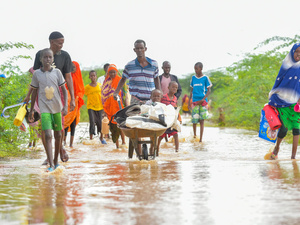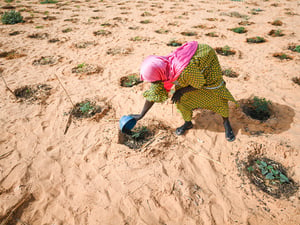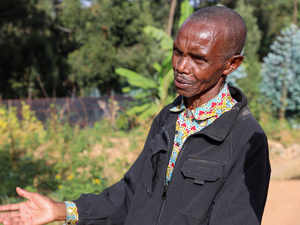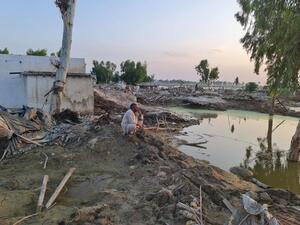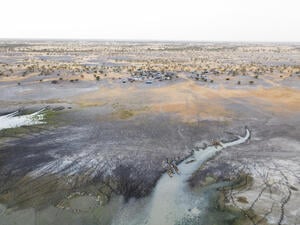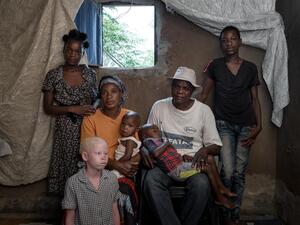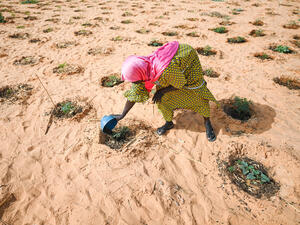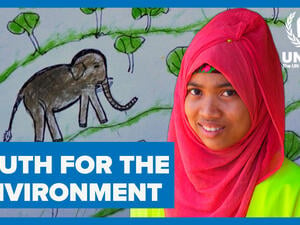Tackling climate change in eastern Chad
Tackling climate change in eastern Chad

Sudanese refugee women prepare to fill their containers with precious water at a camp in eastern Chad.
ABECHE, Chad, December 15 (UNHCR) - Two things that newly arrived aid workers notice pretty quickly in eastern Chad are the lack of water and the sand that seems to get everywhere. With climate change, the situation is likely to get worse - less water and creeping desertification in the semi-arid terrain.
Trying to bathe in Abeche, the main city in eastern Chad, is a major exercise for people used to a regular flow of soothing, cleansing water from showers in more developed nations. Water is only available for a couple of hours once every four or five days and the taps are left open for the magic moment when the flow of H20 gushes out to be collected in an array of pots, pans and buckets.
But for the locals and the 250,000 Sudanese refugees living not too far away in 12 sprawling UNHCR-run camps, washing themselves is an unattainable luxury. They struggle just to get the recommended 15-20 litres per day of water needed for drinking, cooking and cleaning the dust and sand off their hands and faces. Many can only find 5-6 litres.
Water is a scarce resource in eastern Chad at the best of times, but when you are living side by side with thousands of other refugees in a camp, it becomes a major issue. Moreover, there are signs that the annual rainfall has been getting lower and lower, affecting the water table as well as the soil and flora.
UNHCR and its partners, including the Chad government, are addressing the effects of climate change with programmes aimed at better management of dwindling water resources and at holding back desertification by planting trees in one of the driest and hottest countries on earth.
And it's getting drier, with rainfall particularly low in 2009. In the town of Iriba, which hosts 55,000 Sudanese refugees from Darfur in three camps, just 135 millimetres of rain has fallen since the beginning of this year, according to Chad Ministry of Environment figures. This compares to 355mm for the whole of 1950.
The rain nowadays is too little to hold the line against creeping desertification; plants cannot survive for long without sufficient water in the soil. And because of this year's extremely poor rains, the UN expects a food crisis for several million people in Chad and other Sahel countries in 2010.
Moreover, evaporation, diversion of water for agriculture and desertification have seen the once mighty Lake Chad shrink in size from 25,000 square kilometres in the early 1960s to just 3,000 square kilometres today. Heavy winds are moving the Sahara sands southward across the lake.
Lack of water and the dried out soil not only affect bio-diversity but also keep harvests low. As one result, animals don't get enough pasture and many die of malnutrition and related diseases, further affecting the food chain.
Meanwhile, the UN refugee agency has been working in Chad to stem desertification and to mitigate the effects of dwindling water reserves and high consumption. "The only way to fight desertification in the long term is to engage in large reforestation programmes," said Andrea Masini, a UNHCR environment officer. Since 2006, UNHCR has planted 300,000 saplings a year in Chad, out of which some 60 per cent have survived. Refugees and locals have planted another 1.2 million trees, including forest species such as acacia and fruit trees like lemon and mango.
In a further bid to halt desertification, UNHCR and its partners have provided firewood to refugees who would otherwise go out and cut down trees and shrubs - a practice now banned by the government. Alternative fuel sources, such as gas and biogas, have been introduced in Chad and other countries, along with energy saving stoves and solar-powered cookers.
To protect eastern Chad's scarce water reserves, UNHCR and the Ministry of Environment have been implementing a more sustainable strategy. The three-year approach uses a combination of modern and traditional techniques. In the first year, new wells and boreholes have been dug in the camps and surrounding villages, while a special team searches for new underground reserves.
Also this year, the refugee and local communities have been taught to use different water sources for different purposes: for drinking, for livestock, for cultivation and for construction work. As a next step, electrical pumps will be replaced by manual pumps, which are easier to use and cheaper to maintain.
All wells will be naturally replenished each year during the July-September rainy season. By constructing traditional wells in dry river beds, the water reserves deep under the desert will be preserved.
In addressing the effects of climate change today, aid workers, refugees and locals will be helping future generations to continue using the earth's resources in the future in this arid corner of the world.
By Annette Rehrl in Abeche, Chad

